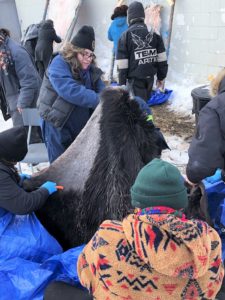Elders and youth take in hide preparation teachings from traditional moose hide tanner

By Rick Garrick
FORT WILLIAM FIRST NATION— A Fort William youth was among a group of people who learned how to create moose bone scraping tools and how to prepare hides during a six-day workshop in Fort William.
“Making the bone tool out of a moose leg was pretty fun,” says Keewaedin Crews, a St. Patrick High School student and Fort William citizen. “You cut it off at the joint of the foot and then you’ve got to shape the bone into the tool with a hacksaw.”
Coty Crews, Keewaedin’s mother and employment counsellor and responsibility officer with Fort William, says the Feb. 10-15 workshop was a “great experience” for her and her three children.
“It was a great way to gather and learn some of the old ways of harvesting hide and just interacting with other First Nation members,” Coty says. “It’s amazing — everyone has been great.”
Melaw Nakehk’o, a traditional moose hide tanner from the Northwest Territories, says it was “really beautiful” to have the Elders and youth participating in the workshop.
“A lot of the youth made tools out of the moose legs,” Nakehk’o says. “We were working on the moose hides with a couple of different techniques just to build skills and to give people in the community an idea of the different tools they need to continue doing hide work.”
Patrick Pelletier, employment and training administration assistant with Fort William and a member of the team that facilitated the workshop, says the workshop focussed on the process from stripping the hide from the animal to preparing it for tanning.
“Learning things about hide and new tricks and new ways of preparing those animals and honouring those animals, that’s always a fun part of these programs,” Pelletier says. “But for me, it’s the interaction, seeing faces you haven’t seen for a long time.”
Brandy Morris, Ontario Works case manager with Fort William, says her two children participated in each of the steps of the workshop.
“They did very well. Yesterday when I took them home from here they wanted to make sure they thanked the Knowledge Keepers,” Morris says. “So it was nice to see that they appreciated what was being offered to them and absorbed it.”
Jayce Morris, a St. Patrick High School student and Fort William citizen, enjoyed learning the hide preparation skills during the workshop.
“I liked getting the hair off the hide,” Jayce says. “You get to push on the sharp [edge of the tool] to get all the long hair off and then you turn it around and push [with] the dull side to get all the shorter hairs off. It was really fun.”
Crissy Wells, a Fort William citizen, says the workshop was “very meditating.”
“I was able to take the fur off and the membrane off,” Wells says. “It is a long process, learning different techniques to do it. Everyone helped everyone, there was lots of support.”
Andrew Mandamin, a Wiikwemkoong citizen, says the workshop was “very educational.”
“It’s not easy— it’s hard work,” Mandamin says. “You really appreciate the work that goes into the moose hide, right from the start to the finished product.”
Alyssa Gagnon from Smooth Rock Falls says she loves doing hide tanning work, noting she has been working on hides since 2018 along with Jean Marshall, a Kitchenuhmaykoosib Inninuwug citizen who lives in Fort William, and Nakehk’o.
“It’s really good work,” Gagnon says. “It’s challenging and it’s also a part of reclaiming my identity as a Mushkego Cree woman.”
Gagnon prepared the brain paste, which is a softening solution for the tanning process, during the workshop.


